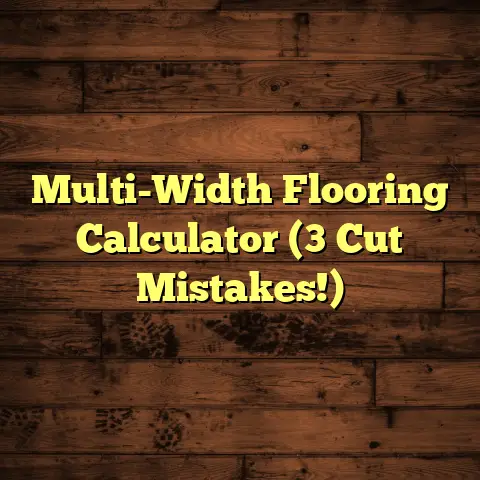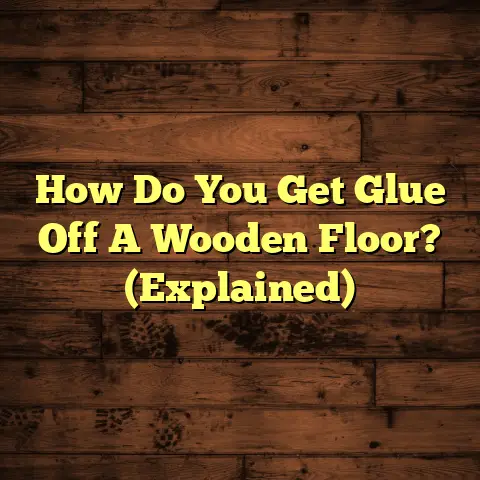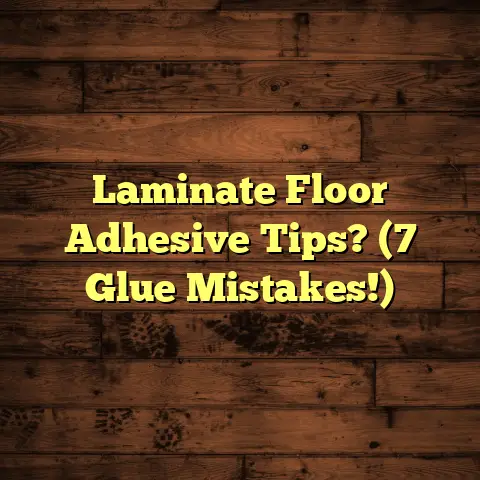What Grit To Sand Wood Floors? (3 Grits To Avoid!)
Let me paint a picture for you.
You’ve just snagged your dream home.
The kind with character, charm, and…
…slightly tired wood floors.
You envision them gleaming, rich, and smooth.
You can almost feel the satisfying texture underfoot.
But then reality hits.
Scratches, stains, and a general dullness stare back at you.
Refinishing those floors becomes your mission.
You’re ready to grab a sander and get to work!
But hold on a minute.
Before you dive in headfirst, there’s a crucial question.
One that can make or break your entire project:
What grit sandpaper do you use?
Trust me, I’ve seen it all in my years as a flooring contractor.
And let me tell you, choosing the wrong grit is a recipe for disaster.
It’s like using a sledgehammer to crack a nut.
You might get the job done, but you’ll leave a mess in your wake!
That’s why I’m here to guide you through the treacherous terrain of sandpaper grits.
I’m going to reveal the three specific grits.
The ones you absolutely must avoid when refinishing your wood floors.
I’ll explain why these choices can lead to irreversible damage, and what to use instead.
Ready to unlock the secrets to sanding success?
Let’s get started!
Section 1: The Importance of Choosing the Right Grit
Okay, let’s talk about why grit matters.
It’s not just some arbitrary number on the back of the sandpaper.
The grit number directly relates to the size of the abrasive particles on the paper.
The lower the number, the coarser the grit.
Think of it like this:
Coarse grits (like 40-60) are like aggressive bulldozers.
They remove material quickly.
They’re meant for heavy-duty tasks.
* Medium grits (like 80-120) are like fine-tuning experts.They smooth things out and remove imperfections.
* Fine grits (like 150-220 and higher) are like polishers.They create a silky-smooth surface ready for finishing.
So, why is choosing the right grit so important?
Well, imagine using that coarse 60-grit sandpaper on a delicate hardwood floor.
You’d end up with deep, unsightly scratches that are difficult, if not impossible, to remove.
On the flip side, using a super-fine grit on a floor with a thick, old finish would be like trying to dig a trench with a spoon.
You’d be there forever, and wouldn’t make much progress.
Here’s a quick rundown of typical grit uses:
As you can see, each grit has its purpose.
Using the wrong one can lead to:
- Damage to the wood: Scratches, gouges, and unevenness.
Poor finish adhesion: The finish won’t bond properly.
It will peel or chip.
* Wasted time and money: You’ll have to redo the job,
buying more materials and spending more time.
I’ve seen DIYers make these mistakes time and time again.
That’s why I’m so passionate about educating people on the importance of grit selection.
Section 2: The Three Grits to Avoid
Alright, let’s get down to the nitty-gritty (pun intended!).
Here are the three sandpaper grits you should approach with extreme caution when sanding wood floors:
1. Grit #1: 60 Grit Sandpaper
This is the big daddy of coarse sandpaper.
60 grit is aggressive, and I mean really aggressive.
It’s designed for removing heavy materials like paint, varnish, or severe damage.
The problem is, most wood floor refinishing projects don’t require this level of aggression.
Why is 60 grit too coarse for most wood floors?
Because it leaves deep scratches.
These scratches are difficult to remove with subsequent grits.
You’ll end up spending hours trying to smooth them out.
You might even have to rent a heavier-duty sander to fix the damage you’ve caused.
I remember one time, a homeowner called me in a panic.
He’d decided to refinish his oak floors himself.
He thought he was being efficient by starting with 60 grit.
He ended up with a floor that looked like it had been attacked by a badger!
The scratches were so deep that I had to use a drum sander to level the floor before I could even start the actual refinishing.
It cost him a lot more money and time than if he’d just started with the right grit in the first place.
When should you not use 60 grit?
- On floors that are relatively smooth: If your floors only have minor scratches or a worn finish, 60 grit is overkill.
On thin wood floors: Aggressive sanding can remove too much material.
It will shorten the lifespan of your floors.
* On soft wood floors:
Softwoods like pine are more susceptible to scratching.60 grit will tear up the surface.
2. Grit #2: 100 Grit Sandpaper
Now, 100 grit isn’t as aggressive as 60 grit.
It’s often used for removing old finishes and initial sanding.
However, it’s still not the ideal starting point for most wood floor refinishing projects.
Why is 100 grit not suitable for initial sanding?
The main issue is that it might not be aggressive enough.
If you’re dealing with a thick, old finish, 100 grit might struggle to remove it efficiently.
You’ll spend a lot of time going over the same areas.
You’ll wear out your sandpaper quickly.
And you might not even get down to the bare wood.
This can lead to problems down the line.
If you don’t remove the old finish completely, the new finish won’t bond properly.
This can result in peeling, chipping, and an uneven look.
I had a client once who tried to save time by skipping the coarser grits.
He started with 100 grit on his polyurethane-coated floors.
A few months later, the new finish started peeling in several spots.
I had to come back and redo the entire job, starting with the appropriate coarser grit to remove the old finish completely.
When should you avoid starting with 100 grit?
- When the existing finish is thick and durable: Polyurethane and epoxy finishes require a coarser grit for effective removal.
- When the floor is uneven: 100 grit might not be aggressive enough to level out significant imperfections.
3. Grit #3: 320 Grit Sandpaper
320 grit sandpaper is a super-fine grit.
It’s typically used for final sanding between coats of finish.
The goal is to create a smooth surface for the next coat to adhere to.
So, what’s the problem with using 320 grit too early in the sanding process?
The issue is that it’s simply not designed for removing material.
It’s designed for polishing and smoothing.
If you try to use it to remove an old finish or level out imperfections, you’ll be wasting your time and sandpaper.
More importantly, using 320 grit before properly sanding with coarser grits can lead to a poor bond with the finish.
The surface will be too smooth.
The finish won’t have enough “tooth” to grip onto.
This can result in the finish peeling or chipping prematurely.
Imagine trying to paint a glossy surface without priming it first.
The paint wouldn’t adhere properly.
It would flake off easily.
It’s the same principle with wood floor finishing.
You need to create a slightly rough surface for the finish to grab onto.
When should you definitely avoid using 320 grit early on?
- Before removing the old finish: Always use coarser grits to strip the old finish completely.
- Before leveling the floor: Address any unevenness or imperfections with coarser grits first.
As a substitute for proper sanding: 320 grit is not a shortcut to a smooth finish. It’s the final step in a multi-step sanding process.
Section 3: The Correct Grits to Use Instead
Okay, now that we’ve covered the grits to avoid, let’s talk about the grits you should be using.
The key to successful wood floor sanding is to use a progressive sanding process.
This means starting with a coarser grit to remove the old finish and level the floor.
Then, gradually moving to finer grits to smooth the surface.
Here’s a general step-by-step sanding process that I recommend:
Initial Sanding (40-60 grit):
- Use this only if you have a very thick finish, significant damage, or an uneven floor.
- Use this only if you have a very thick finish, significant damage, or an uneven floor.
Main Sanding (80-100 grit):
- This is your primary sanding step.
- It removes the remaining finish and smooths out the scratches from the coarser grit (if used).
Smoothing (120-150 grit):
- This step refines the surface and prepares it for finishing.
- It removes any remaining imperfections and creates a smooth, even texture.
Final Sanding (180-220 grit):
- This is the final sanding before applying the finish.
- It creates a silky-smooth surface that will allow the finish to bond properly.
Important Considerations:
- Wood Type: Softer woods like pine require finer grits than hardwoods like oak.
Finish Type: Some finishes require a specific grit range for optimal adhesion.
Always check the manufacturer’s recommendations.
* Floor Condition: Severely damaged floors might require
more aggressive sanding than floors in good condition.
Why does starting with the right coarser grit lead to a smoother finish?
It’s all about creating a consistent surface.
By starting with a grit that’s appropriate for the job.
You’re ensuring that you’re removing the old finish and leveling the floor evenly.
This creates a solid foundation for the finer grits to work their magic.
If you try to skip the coarser grits, you’ll end up with an uneven surface that’s difficult to smooth out.
You’ll also risk leaving behind remnants of the old finish, which can cause adhesion problems.
Section 4: Real-Life Examples and Case Studies
Let me share a couple of stories to illustrate the importance of grit selection:
Case Study 1: The Overzealous DIYer
A homeowner decided to refinish his hardwood floors himself.
He watched a few YouTube videos and thought he was ready to go.
He started with 60 grit sandpaper, thinking he’d save time.
Unfortunately, he ended up with deep scratches all over his floors.
He tried to smooth them out with finer grits, but it was no use.
The scratches were too deep.
He had to call me in to fix the damage.
I had to use a drum sander to level the floor.
Then, I started the refinishing process from scratch, using the correct grits.
It cost him a lot more money and time than if he’d just hired a professional in the first place.
Case Study 2: The Finish Peeling Fiasco
Another homeowner tried to refinish her floors on a budget.
She skipped the coarser grits and started with 100 grit.
She thought she was saving time and sandpaper.
However, she didn’t remove the old finish completely.
A few months later, the new finish started peeling in several spots.
The problem was that the new finish wasn’t bonding properly to the old finish.
I had to come back and redo the entire job.
I started with the appropriate coarser grit to remove the old finish completely.
Then, I applied a new finish.
This time, the finish bonded properly, and the floors looked beautiful.
These stories highlight the importance of understanding grit selection and using a progressive sanding process.
Don’t try to cut corners or take shortcuts.
It will only cost you more time and money in the long run.
Section 5: Conclusion
So, there you have it!
The lowdown on sandpaper grits and how to choose the right ones for your wood floor refinishing project.
Remember, grit selection is crucial for achieving a beautiful, durable finish.
Avoid the three grits I mentioned – 60, 100, and 320 – unless you have a very specific reason to use them.
Instead, use a progressive sanding process, starting with a coarser grit and gradually moving to finer grits.
Pay attention to the type of wood, the type of finish, and the condition of your floors.
And don’t be afraid to ask for help from a professional if you’re unsure about anything.
With a little bit of knowledge and preparation, you can achieve amazing results and transform your tired wood floors into a stunning centerpiece of your home.
Now, go forth and sand with confidence!
Your dream floors await!





